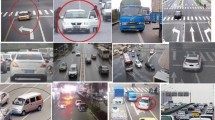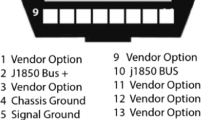Abstract
An electronic system capable of estimating the road surface status in real time, and among dry/wet/icy/snowy is shown. The system is mainly based on the analysis of the tyre/road noise generated during vehicle driving. The sound emission pattern of the tyre/road interaction changes dramatically depending on whether the pavement is dry, wet, icy or snowy. Thus discriminating the tyre/road noise acoustic footprint, it is possible to estimate the road status. To be able to distinguish this acoustic footprint, a Support Vector Machines (SVM) based classifier has been developed. Tyre/road noise is initially captured using a properly conditioned microphone. The obtained signal is digitized and pre-processed, extracting its spectral components to produce the feature vector that will be fed to classifier. Finally the classifier estimates the condition of the asphalt, which may be broadcast through the vehicle communication interface, to be shown on the console, or to be used by other subsystems in order to improve safety and comfort. The connection to the vehicle engine control units through its communications interface, also allows obtaining information on its dynamic variables, allowing improving the results obtained by the classifier. Before the system is able to operate properly, the classifier needs to be trained. In initial tests, the system has been trained to distinguish the states of dry and wet asphalt, yielding success rates around 91 % and an average response time in the transition from dry to wet of about 0.2 s. These results demonstrate the feasibility of the system. Currently, a reference implementation of the system is under development. It integrates all the elements needed in a board of reduced size and low cost. Current implementation of the system could improve security by issuing a slippery asphalt warning, when it detects wet asphalt. Data obtained may also be used by the traction control subsystem to improve safety and comfort. Additional work is being made to extend the classifier algorithms to detect icy and snowy asphalt states.
Resumen
En este trabajo, se presenta un sistema electrónico para estimar el estado del asfalto en tiempo real entre cuatro posibles situaciones: seco, mojado, hielo y nieve. El sistema se basa principalmente en el análisis del ruido de rodadura generado durante la marcha del vehículo. El patrón de emisión sonora de la interacción neumático pavimento cambia notablemente dependiendo de si el asfalto está seco, mojado, cubierto de hielo o cubierto de nieve. Por tanto, discriminando la huella acústica del ruido de rodadura, es posible determinar el estado del asfalto. Para poder distinguir esta huella acústica, se ha desarrollado un clasificador, basado en máquinas de vectores soporte (Support Vector Machines o SVM). El ruido de rodadura es captado inicialmente por un micrófono debidamente acondicionado. La señal obtenida es digitalizada y pre-procesada, extrayéndose de ella sus componentes espectrales para elaborar el vector de características que usará el clasificador. Este clasificador finalmente realiza una estimación del estado del asfalto, que podrá ser difundida a través de la interfaz de comunicaciones del vehículo, para ser mostrada en la consola del mismo, o para que sea utilizada por otros subsistemas con el fin de mejorar la seguridad y confort. La conexión con las centralitas del vehículo a través del interfaz de comunicaciones del mismo, también permite obtener información de las variables dinámicas, permitiendo mejorar los resultados obtenidos por el clasificador. Antes de que el sistema pueda funcionar correctamente, el clasificador ha de ser entrenado. En las pruebas iniciales, el sistema ha sido entrenado para distinguir los estados de asfalto seco y mojado, obteniéndose tasas de acierto alrededor del 91 %, y un tiempo medio de respuesta en la transición de seco a mojado de unos 0,2 s. Estos resultados demuestran la viabilidad del sistema. Actualmente se está desarrollando una implementación de referencia en forma de prototipo de tamaño reducido que integra todos los elementos necesarios del sistema en una tarjeta de reducidas dimensiones y bajo coste. La implementación actual del sistema podría mejorar la seguridad mediante la emisión de un aviso de asfalto resbaladizo, cuando se detecta una condición de asfalto mojado. Los datos obtenidos podrían ser utilizados también por el subsistema de control de tracción para mejorar la seguridad y confort. Adicionalmente se está trabajando en extender la detección a los estados de asfalto helado y asfalto nevado.





Similar content being viewed by others
Referencias
Einhorn, H. J., & Hogarth, R. M. (1982). A theory of diagnostic inference. I. Imagination and the psychophysics of evidence [M]. Chicago Univ Il Center for Decision Research: Defense Technical Information Center.
Erke, A., Sagberg, F., & Hagman, R. (2007). Effects of route guidance variable message signs (VMS) on driver behavior [J]. Transportation Research Part F: Traffic Psychology and Behaviour, 10(6), 447–457.
Guyon, I., Weston, J., Barnhill, S., & Vapnik, V. (2002). Gene selection for cancer classification using support vector machines [J]. Machine Learning, 46(1), 389–422.
Norrman, J., Eriksson, M., & Eriksson, M. (2000). Relationships between road slipperiness traffic accident risk and winter road maintenance activity [J]. Climate Research, 15(3), 185–193.
Rämä, P. (1999). Effects of weather-controlled variable speed limits and warning signs on driver behavior [J]. Transportation Research Record: Journal of the Transportation Research Board, 1689(-1), 53–59.
Rämä, P. (1999). Effects of weather-controlled variable speed limits and warning signs on driver behavior [J]. Transportation Research Record: Journal of the Transportation Research Board, 1689(1), 53–59.
Theodoridis, S., & Koutroumbas, K. (2009). Pattern recognition [M]. Elsevier/Academic Press. ISBN 9781597492720.
Wallman, C. G. (1997). Driver behaviour on winter roads: A driving simulator study [M]. VTI Rapport 419A. Swedish National Road and Transport Research Institute.
Weston, J., Elisseeff, A., Schölkopf, B., & Tipping, M. (2003). Use of the zero norm with linear models and kernel methods [J]. The Journal of Machine Learning Research, 3, 1439–1461.
Weston, J., Elisseeff, A., BakIr, G., & Sinz, F. (2006). The spider. <http://people.kyb.tuebingen.mpg.de/spider/>.
Author information
Authors and Affiliations
Corresponding author
Rights and permissions
About this article
Cite this article
Alonso, J., López, J.M., Pavón, I. et al. Road state estimation based on acoustic analysis. Securitas Vialis 7, 13–19 (2015). https://doi.org/10.1007/s12615-014-9076-9
Published:
Issue Date:
DOI: https://doi.org/10.1007/s12615-014-9076-9
Keywords
- New in-vehicle technologies
- Prevention
- Intelligent transportation
- Tyre/road noise
- Support vector machines




